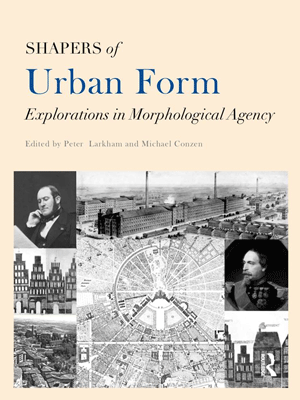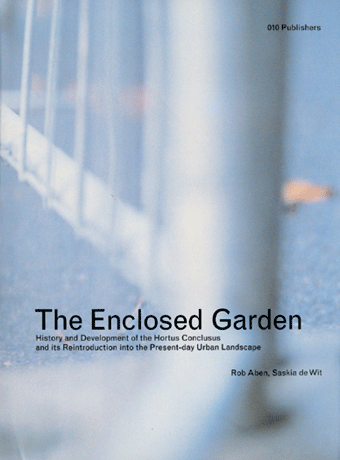
Overlooking the visual
Demystifying the art of design
Kathryn Moore
Based on a radical new definition of perception that has starting consequences for conceptions of language, intelligence, meaning, the senses, emotions and subjectivity, this book makes tangible connections between theory and practice, ideas and form, nature and culture.
Watch Kathryn Moore in Harvard's Lecture Series

Shapers of Urban Form
Explorations in Morphological Agency
Peter Larkham, Michael Conzen
Who makes or towns and cities?
The form of settlements – cities, towns and even smaller places – is crucial to many qualities of our ways of life. How close do we live to places of work, retail or recreation?
The complexity of both urban form and the processes involved in shaping it increase towards the present as more and different stakeholders are involved, and as governance, space and benefits are privatised.

Moving Horizons
The Landscape Architecture of Kathryn Gustafson and Partners
Jane Amidon
US American landscape designer Kathryn Gustafson has gained an outstanding international reputation. Her current work focuses on public spaces. The recently opened Diana, Princess of Wales Memorial Fountain in Hyde park, London is the latest in a long list of acclaimed projects realised together with her partners Gustafson Porter (London) and Gustafson Guthrie Nichol (Seattle).

Designing Parks
An examination of contemporary approaches to design in landscape architecture
Lodewijk Baljon
Without imagination a park is a mere dry decor for people who come and go - a meaningless facade whereas it should be the most artistic of landscape architecture. This present study contributes to the formation of theories of landscape design by means of a comparative design analysis.

Recovering Landscape
Essays in Contemporary Landscape Architecture
James Corner
The past decade has been witness to a remarkable resurgence of interest in landscape. While this recovery invokes a return of past traditions and ideas, it also implies renewal, invention, and transformation.
Recovering Landscape collects a number of essays that discuss why landscape is gaining increased attention today, and what new possibilities might emerge from this situation.

Landscape for Living
Garrett Eckbo
This desirable book was first published in 1950 and has long been out of print. Educated at Harvard and UC Berkeley, Eckbo created garden and landscape designs that were instrumental in establishing the new modernist spirit that infused California architecture and design during and after WWII. This book is a survey of Eckbo's work, both civic and private, and a fascinating overview of the history and practice of landscape design.

GROSS MAX
Uje Lee, JaeWon Lee, Jun Choi, Gross Max

Open to the sky
Malene Hauxne
The second phase of the modern breakthrough 1950-1970 ; building and landscape, spaces and works, city landscape

The Landscape of Man
Shaping the environment from prehistory to the present day
Geoffrey Jellicoe
To qualify as a ''landscape of man'', an environment must be deliberately shaped at a specific time. Its form will be conditioned by the civilization that produced it, and therefore to explain it fully one has to go not only to history but to philosofy and religion.

Gardens
Dieter Kienast
Contemporary landscape architecture is seeking a modern and independent language. Dieter Kienast is one of the leading protagonists of this movement. He has won many public competitions in Germany, Austria and Switzerland. This monograph is the first to present his complete works on private gardens and parks: around 30 designs, 22 of which have been realized, are discussed.

Designing for a Region
Nancy Meijsmans
The fourth edition in a series called Explorations in/of Urbanisms which aims to fill a gap in the contemporary debate concerning urbanism. Central to the thesis presented here is the idea that the regional scale is becoming more and more important to help tackle spatial questions such as the accommodation of dwelling needs or water storage.

The Modern Urban Landscape
Edward Relph
Brings together urban history, urban form, public planning history, the literature of utopianism, and the architecture of cities in an intelligent, coherent, lively, and controversial portrayal of the evolution of the physical characteristics of Anglo-American urban environments since 1880.

The Landscape of Contemporary Infrastructure
Kelly Shannon Marcel Smets
The Landscape of Contemporary Infrastructure investigates how infrastructure design determines the organization and flow of the inhabited landscape-as an agency of enhanced mobility, as a design feature contributing to the character of a city and as a sound theoretical approach to a positive experience of collective space.

Great City Parks
Alan Tate
Great City Parks is a celebration of some of the finest achievements of landscape architecture in the public realm. It is a comparative study of twenty significant public parks in fourteen major cities across Western Europe and North America. Collectively, they give a clear picture of why parks have been created, how they have been designed, how they are managed, and what plans are being made for them at the beginning of the twenty-first century.

Modern Landscape Architecture: a critical review
Marc Treib
During the 1930s Garrett Eckbo, Dan Kiley, and JamesRose began to integrate modernist architectural ideas into their work and to design a landscape more in accord with the life and sensibilities of their time. Together with Thomas Church, whose gardens provided the setting for California living, they laid the foundations for a modern American landscape design.

The Landscape Urbanism Reader
Charles Waldheim
In The Landscape Urbanism Reader Charles Waldheimwho is at the forefront of this new movement has assembled the definitive collection of essays by many of the field's top practitioners. Fourteen essays written by leading figures across a range of disciplines and from around the worldincluding James Corner, Linda Pollak, Alan Berger, Pierre Blanger, Julia Czerniak, and morecapture the origins, the contemporary milieu, and the aspirations of this relatively new field.

Dirt
Megan Born, Helene Furjan, Lily Jenks with Phillip M. Crosby
Dirt presents a selection of works that share dirty attitudes: essays, interviews, excavations, and projects that view dirt not as filth but as a medium, a metaphor, a material, a process, a design tool, a narrative, a system.
Rooted in the landscape architect's perspective, Dirt views dirt not as repulsive but endlessly giving, fertile, adaptive, and able to accommodate difference while maintaining cohesion.

The Enclosed Garden
History and Development of the Hortus Conclusus and its Reintroduction into the Present-day
Rob Aben, Saskia de Wit
Making its first appearance in Medieval Europe, the hortus conclusus or enclosed garden captures and isolates aspects of nature and landscape in a relatively, small confined space.
The book opens with a historical section describing the ingredients and design concepts that made hortus conclusus such a success.



